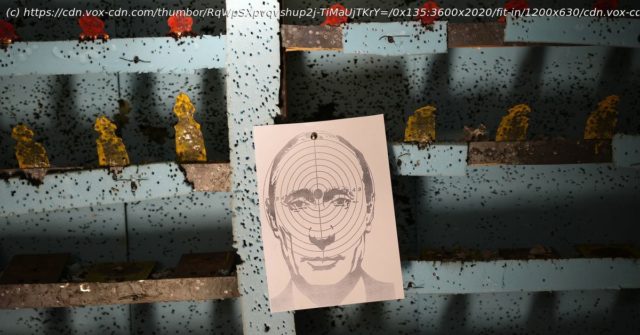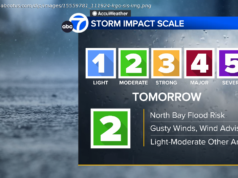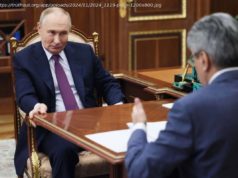Russia’s offensive is stalled. It has taken massive casualties. We are, according to one expert, «seeing a country militarily implode.»
It has been a little over three weeks since Russia initially invaded Ukraine. And by most accounts, the Russian war effort has been a disaster. The initial Russian invasion plan, a lightning march aimed at conquering Kyiv, collapsed within days. Since then, the Russians have adjusted to a more gradual advance backed by heavy artillery fire, an approach that has allowed them to make some noticeable territorial gains. But these advances appear to have been halted, at least temporarily. On Thursday, the UK Defense Intelligence Agency assessed that Russia’s offensive “ has largely stalled on all fronts,” a judgment echoed by open source analysts tracking developments on the ground. The Wall Street Journal reported on Wednesday that Ukrainian forces have even managed to mount a counteroffensive around Kyiv. Russian casualties have been horrifically high. It’s hard to get accurate information in a war zone, but one of the more authoritative estimates of Russian war dead — from the US Defense Department — finds that over 7,000 Russian soldiers have been killed in the first three weeks of fighting, a figure about three times as large as the total US service members dead in all 20 years of fighting in Afghanistan. “We’re seeing a country militarily implode,” says Robert Farley, a professor at the University of Kentucky who studies air power. This is not how the war was supposed to go. On virtually any quantifiable metric of military strength, from defense spending to the size of the respective air forces, Russia’s forces vastly outnumber and outgun Ukraine’s. In early February, Chairman of the Joint Chiefs Mark Milley told members of Congress that Kyiv could fall within 72 hours of a Russian invasion. But Russia’s military has proven more incompetent, and Ukraine’s more capable, than nearly anyone anticipated. “Having spent a chunk of my professional career [working] with the Ukrainians: Nobody, myself included and themselves included, had all that high an estimation of their military capacity,” says Olga Oliker, the program director for Europe and Central Asia at the International Crisis Group. There are many reasons things have turned out this way. Generally speaking, it appears that pre-war analyses overrated Russia’s hardware advantage and underrated less tangible factors — including logistical capacity and the morale of the front-line combat troops on both sides. Morale in particular “is a very significant factor in Russian combat effectiveness, and one that’s being ignored by many military observers,” argues Michael Kofman, director of Russia studies at the CNA think tank. All that said, it is still far too early to conclude that Ukraine is going to win the war. Ukrainians have suffered significant losses, too; Russia’s numerical and technological advantages remain and could yet prove decisive, allowing the Russians to besiege Ukraine’s major cities and starve them into submission. But right now, based on the publicly available evidence we have, the momentum is clearly going the other way. An unqualified Russian victory, which once seemed almost inevitable, is looking increasingly less likely. Russia’s gains have been real — but are stalling out On paper, Russia’s military vastly outstrips Ukraine’s. Russia spends over 10 times as much on defense annually as Ukraine; the Russian military has a little under three times as much artillery as Ukraine and roughly 10 times as many fixed-wing aircraft. Given this disparity, Russia was bound to be able to make some inroads into Ukrainian territory. And as you can see on the following map from the Institute for the Study of War (ISW), Russia had seized control of notable chunks of Ukrainian territory by March 9 — especially in the south, where it controls the cities of Melitopol and Kherson: But these advances were not necessarily the sole result of Russian battlefield supremacy. Ukraine, Kofman explains, made the tactical decision to trade “space for time”: to withdraw strategically rather than fight for every inch of Ukrainian land, fighting the Russians on the territory and at the time of their choosing. As the fighting continued, the nature of the Ukrainian choice became clearer. Instead of getting into pitched large-scale battles with Russians on open terrain, where Russia’s numerical advantages would prove decisive, the Ukrainians instead decided to engage in a series of smaller-scale clashes. Ukrainian forces have bogged down Russian units in towns and smaller cities; street-to-street combat favors defenders who can use their superior knowledge of the city’s geography to hide and conduct ambushes. They have attacked isolated and exposed Russian units traveling on open roads, which make for easy targets. They have repeatedly raided poorly protected supply lines with an eye toward denying Russians necessary materials like fuel. A recent Washington Post account of a battle near the Kyiv suburb of Brovary, based on Ukrainian military videos and interviews with witnesses, paints a clear picture of how this has played out: The Ukrainian defensive strategy has not fully thrown Russia’s advance back, but it has slowed it to a near halt. ISW’s updated March 17 map shows that Russian forces have barely moved forward from their positions about a week earlier — a reflection of Ukrainian success: Again, the Russian advancement mostly came in the south, where they continue to besiege the port city of Mariupol. Their current aim appears to be to do the same to Kyiv in the north, cutting it off from food and water and bombarding it with artillery.






